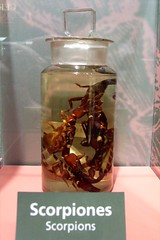Roman Funerary Art at the Museum of Fine Art, BostonFUNERARY PORTRAIT RELIEFS
During the late Republican and Augustan periods (about 70 B.C.-A.D. 14), funerary reliefs with portraits of the deceased and members of their families were popular. Almost without exception the portraits are of freed slaves (liberti) and their offspring. The portraits are frequently accompanied by inscriptions that indicate the professions and family relationships of the people in the relief. Occasionally, a slave's former owner was also shown. The reliefs were inserted into the tombs that lined the roads leading out of Rome. This use of funerary portrait reliefs saw a resurgence in the second century A.D.(from the display card for
Funerary Relief of the Publius Gessius Family)
The MFA has many wonderful Roman antiquities. Here are some of the Funerary Portraits, Cinerary Urns, and Sarcophagi that they display.
long post, with complete transcribed display information, just keep scrolling
Funerary Relief of a Mother and Son
Roman, Imperial period, about A.D. 110-120
Marble
This panel came from a tomb that, as the inscription records, Petronia Hedone made for herself and her son as well as her fredd slaves and their descendants. The resemblance of Petronia's hair to that of Martiana (died A.D. 112), Emperor Trajan's sister, suggests the relief's date, though the use of drilled holes for the pupils of the eyes rarely occurs before the reign of Hadrian (A.D. 117-138).
Henry Lillie Pierce Fund, 1899 99.348
Inscription
Petronia Hedone fecit sibi/et L(ucio) Petronio Philemoni filio/et libertis libertabusquae/posterisquae eorum
Petronia Hedone made [this] for herself and for Lucius Petronius Philemon, her son, and for [her] freedmen and freedwomen and their descendants

 Sarcophagus with Triumph of Dionysus
Sarcophagus with Triumph of DionysusMarble (from the island of Proconnesus, Turkey)
Dionysus, also known as Bacchus, was the god of wine and drama. He is one of the most frequently depicted gods in ancient art and is often shown in the company of mythological beings like satyrs, silens, and maenads as well as such animals as lions, panthers, and snakes. The inclusion of an elephant-drawn chariot and a giraffe in the procession identify the scene as the god's triumphal return from spreading his cult to India. Dionysiac imagery frequently occurs in Roman funerary art, and may reflect the beliefs of the deceased.
William Francis Warden Fund, 1972 1972.650



Funerary Relief of the Publius Gessius Family
Roman, late Republican period, about 50-20 B.C.
Marble (probably from Carrara, Italy)
The Latin inscription at the base identifies the central figure as Publius Gessius, a Roman citizen in military costume. He is flanked by Fausta Gessia, a slave whom he had freed, and by their son, R. Gessius Primus, also a freed slave. The inscriptions on the sides indicate that Fausta built the tomb that held this relief with money provided in Primus's will, a common practice in antiquity.
Archibald Cary Coolidge Fund, 1937 37.100
Inscriptions
Lower Edge:
Gessia P(ubli) l(iberta) Fausta/P(ublius) Gessius P(ubli) f(ilius) (tribu) Rom(ilia)/P(ublius) Gessius P(ubli) l(ibertus) Primus
Gessia Fausta, freedwoman of Publius/Publius Gessius, son of Publius, of the Romilian tribe/Publius gessius Primus, freedman of Publius
Left:
ex testam[ento]/P(ubli) Gessi P(ubli) l(iberti)/Primi
From the testament of Publius Gessius Primus, freedman of Publius
Right:
Arbi(tratu)/Gessia[e P(ubli) l(ibertae)]/Fausta[e]
Under the direction of Gessia Fausta, freedwoman of Publius


Cinerary Urn with Offering Scene
Roman, Imperial period, about A.D. 150
Marble (from the island of Proconnesus, Turkey)
In this scene of piety, a man pours an offering of wine over an altar while a woman raises her hands in prayer. A flute player provides music, a frequent component of ancient sacrifices. The side panels show the eagle of Jupiter and the peacock of Juno, each holding a victory wreath. Cinerary urns and sacrophagi were usually produced in workshops near quarries and shipped to urban centers of sale. The faces of this couple were prepared for portraits that were never carved, perhaps due to a sudden death and the need to use the urn immediately.
Museum purchase with funds donated in memory of Emily Townsend Vermeule, 2002 2002.25
(from the display card)

Cinerary Urn of L. Cassius Colonus Colonianus
Roman, late imperial period, about A.D. 200
Marble (from the Greek island of Thasos)
This urn held the ashes of Lucius Cassius Colonus Colonianus, a member of the social class known as the equites (roughly "knights"). The urn is densely covered with figures representing the death of Pentheus, king of Thebes, a story known from Euripides's play 'The Bacchae'. Pentheus opposed the presence of Dionysus in his city and spied upon the women celebrating the god's rites. This scene shows the play's climax, when the women of Thebes, driven into the ecstatic state associated with the worship of Dionysus, tear Pentheus apart. Dionysus, standing on the left, witnesses this scene, accompanied by his thiasos (entourage) of satyrs, silens, and maenads.
Benjamin and Lucy Rowland Fund, 1972 1972.356
Inscription
D(is) M(anibus) L(uci) Cassi Coloni Coloniani eq(uitis) R(omani)/vixit ann(is) XXXV
To the spirits of the dead of Lucius Cassius Colonus Colonianus, a Roman eques; he lived thirty-five years.
Labels: art research, arts, cabinet of curiosities, culture, history, knowledge, memento mori, museums, photography, sculpture



















.JPG)





+1945-46.jpg)
+1936.jpg)













